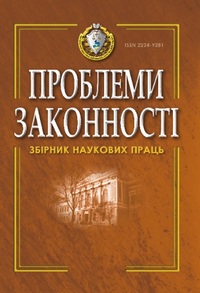Current State of Legal Protection of Migratory Wild Animal Species in Ukraine: Challenges and Prospects
DOI:
https://doi.org/10.21564/2414-990X.169.334008Keywords:
migration corridors, ecosystem services, war-related environmental damage, CMS, institutional implementationAbstract
Russia’s full-scale armed aggression against Ukraine has severely degraded the habitats of wild migratory species and disrupted their traditional flyways, which form a key component of the European ecological network. These new challenges have simultaneously exposed gaps in domestic legislation and revealed the inability of existing financial instruments to respond rapidly to ecological crises. Objective. The article evaluates the current state of legal protection for migratory wildlife in Ukraine, identifies the main shortcomings and offers a set of integrated solutions aligned with the country’s EU-integration commitments. Methods. The study relies on in-depth content analysis of ratified international treaties, current Ukrainian statutes, the 2022 governmental damage-assessment guidelines and a curated set of recent academic publications; comparative-legal, systems and case-study approaches are applied, with special focus on war-impacted Ramsar sites in the Black Sea–Azov region. Results. Military operations have destroyed or polluted more than 1.2 million ha of protected areas, while existing damage-assessment methods ignore losses of the ecosystem service “migration support.” Law of Ukraine “On the Animal World” merely proclaims corridor protection without recovery procedures; the 2030 Environmental Strategy remains unfunded; neither a legal status for “migration corridor” nor an Ecosystem-Services Act exists, preventing monetisation of losses and their compensation through reparations. Conclusions. Three priority avenues for improvement are proposed: (1) developing and implementing a valuation method for the ecosystem service of migration support; (2) legally anchoring corridors within the protected-area system under a dedicated protection regime; and (3) establishing a Corridor Recovery Fund to channel war reparations and ecosystem-service payments, thereby creating a sustainable financial mechanism for post-war restoration of migration routes.
References
Patseva, I.H., Alpatova, O.M., Demchuk, L.I., Kireitseva, H.V., & Levytskyi, V.H. (2022). Current state of the natural environment under the influence of war. Ecological Sciences, (4), 19–22.
Convention on the Conservation of Migratory Species of Wild Animals. (1979, June 23). Retrieved from https://zakon.rada.gov.ua/laws/show/995_136#o32
Law of Ukraine No. 2894-III “On the Animal World” of December 13, 2001 (last updated November 15, 2024). Retrieved from https://zakon.rada.gov.ua/laws/show/2894-14#Text
Law of Ukraine No. 2697-VIII “On the Basic Principles (Strategy) of the State Environmental Policy of Ukraine until 2030” of February 28, 2019. Retrieved from https://zakon.rada.gov.ua/laws/show/2697-19#Text
Suietnov, Y. (2024). The concept of ecosystem services in Ukrainian environmental legislation. Grassroots Journal of Natural Resources, 7(2), 370–392. https://doi.org/10.33002/nr2581.6853.070219
Rodríguez Goyes, D., Mol, H., Brisman, A., & South, N. (2023). Global South and the limits of international environmental law. Crime, Law and Social Change, 79(2), 123–145. https://doi.org/10.1007/s10611-023-10117-7
Volchenko, M.V. (2023). State policy on the protection of the animal world. Kyiv Journal of Law, (1), 169–174.
Chopko, Kh. (2022). Peculiarities of legal regulation of the use and protection of wild animals under the legislation of Ukraine and the European Union. Bulletin of Lviv University, (75), 139–145.
Hreshchuk, H., Ratushna, B., & Muzyka, Y. (2023). Ecological rights as the objects of judicial protection (considering practice of the European Court of Human Rights). Review of Economics and Finance, 21, 351–356.
Suietnov, Y., & Tulina, E. (2021). Ecosystem approach in dealing with invasive alien species: International, European and Ukrainian experience of legal regulation. Grassroots Journal of Natural Resources, 4(3), 79–93. https://doi.org/10.33002/nr2581.6853.040308
Shekhovtsov, V.V. (2020). Scientific and methodological principles of management in the field of protection, use and reproduction of the animal world: problems of implementation and ways of improvement. Legal Bulletin, (3), 148–155.
Kazanchuk, I.D. (2022). On improving the organizational and legal regulation of relations in the field of protection and use of the animal world and combating poaching during martial law in Ukraine. Bulletin of Kharkiv National University of Internal Affairs, (2), 172–182.
Cabinet of Ministers of Ukraine. (2022, March 20). Resolution No. 326 “On approval of the Procedure for determining damage and losses caused to Ukraine as a result of the armed aggression of the Russian Federation”. Retrieved from https://zakon.rada.gov.ua/laws/show/326-2022-п#Text
European Commission. (2020). EU biodiversity strategy for 2030: Bringing nature back into our lives (COM(2020) 380 final). Brussels, Belgium. Retrieved from https://eur-lex.europa.eu/legal-content/EN/TXT/?uri=CELEX:52020DC0380
Nakamura J., Weston, J.C.L., & Lennan, M. (2023). International legal responses for protecting fishers’ fundamental rights impacted by a changing ocean. The International Journal of Marine and Coastal Law, 38, 516–544.
Downloads
Published
How to Cite
Issue
Section
License
Copyright (c) 2025 Єгор Кононенко

This work is licensed under a Creative Commons Attribution 4.0 International License.










